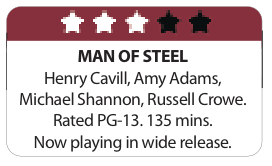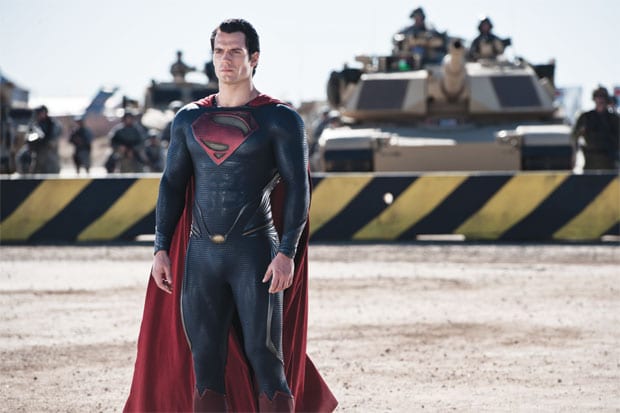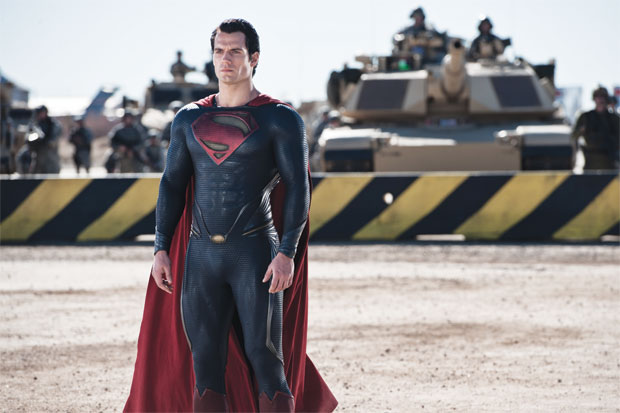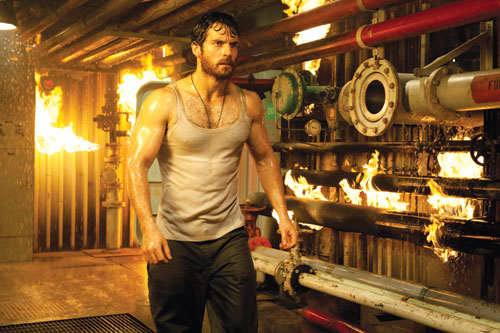Zack Snyder explores a softer side to the ‘Man of Steel’
ARNOLD WAYNE JONES | Life+Style Editor
The thing about iconic characters is, they can never get away from their history. James Bond has to be a womanizer, Hamlet has to be indecisive, Clark Kent has to wear spectacles.
Or does he?
 Zack Snyder, the director who made war movies seem uber-gay with 300, fiddles a lot with Krypton’s favorite son in the Superman reboot Man of Steel — to the point where the word “Superman” is only uttered once, and that’s near the end. Clark eventually does pull out the eyeglasses, but only after Snyder has undermined most of what we have come to identify as the mythology of Krypton’s Kal-El. Clark (Henry Cavill as an adult) was a farmboy who made it in the big city as a “mild-mannered reporter for the Daily Planet” while keeping his identity a secret from Lois Lane (Amy Adams). It was always a lark that a hard-nosed investigative journalist like Lois couldn’t ferret out the alter ego of Superman, simply by looking at Clark with his glasses off.
Zack Snyder, the director who made war movies seem uber-gay with 300, fiddles a lot with Krypton’s favorite son in the Superman reboot Man of Steel — to the point where the word “Superman” is only uttered once, and that’s near the end. Clark eventually does pull out the eyeglasses, but only after Snyder has undermined most of what we have come to identify as the mythology of Krypton’s Kal-El. Clark (Henry Cavill as an adult) was a farmboy who made it in the big city as a “mild-mannered reporter for the Daily Planet” while keeping his identity a secret from Lois Lane (Amy Adams). It was always a lark that a hard-nosed investigative journalist like Lois couldn’t ferret out the alter ego of Superman, simply by looking at Clark with his glasses off.
Snyder changes all that around: Lois and Clark meet before he becomes a reporter, and she learns his true identity early on. We barely catch a glimpse of Lana Lang, and aside from “LexCorp” signage peppered around, Lex Luthor doesn’t come up at all.
Instead, Clark’s nemesis (as it was in 1980’s Superman II) is treasonist warmonger General Zod (Michael Shannon, such a peculiar looking actor he doesn’t even need makeup to appear alien), who follows Kal-El to Earth with the plan to re-colonize his homeworld here.
In terms of plot, Man of Steel should be called Man of Steal: It pilfers not only from prior Superman movies, but Independence Day, the Star Trek franchise, The Dark Knight, Thor (eek! A Marvel character!) and more. But Snyder mixes up the storytelling, with flashbacks and mind-probing and the digital essence of Jor-El (Russell Crowe), Kal’s bio-dad. (Best thing about Crowe’s performance? He doesn’t sing.)
Snyder and his scenarists — Christopher Nolan, who not coincidentally directed The Dark Knight, and David S. Goyer — have made Man of Steel both hyper-realistic and outrageously silly. The cinematography employs harsh lighting and a neutral palette (the colors aren’t just muted, they’re positively dumb-struck), emphasizing textures, especially of the actors’ deglamorized faces. The women appear older, more haggard, without the mask of makeup; the men craggy and shop-worn (even Cavill, whose protean face toggles somewhere between “handsome” and “plate of mashed potatoes”). It feels almost like a black-and-white movie, or perhaps a dog-eared issue of Action Comics left too long in a tree fort.
Snyder adds to the verisimilitude by employing a shaky, handheld look in many of the action sequences, imbuing a kind of YouTube reality overlaid on the CGI. In 1978, Superman The Movie marketed itself with “You will believe a man can fly.” Today, we believe buildings can fly and bullets can bend — and that’s in 30-second commercials. This style changes the rulebook for what seems “real.” (It teases you with what the Spider-Man franchise would look like if taken over by Terrence Malick.)
But then Snyder overdoes it, with action sequences that can become as muddled as a Transformers movie. (The cameraman, Amir Mokri, has DP’d several Michael Bay pictures.) He seems especially tone-deaf to the idea of ravaging New York City — pardon: Metropolis — in a post-9/11 era. It’s a sad function of our society that following a spate of Roland Emmerich movies where the devastation of the Big Apple — whether by flood, tidal wave, alien or Godzilla — is considered commonplace that no one hesitates to bring skyscrapers crashing down like Osama bin Laden’s wet dream.
In many ways, Man of Steel is the obverse of Dark Knight: Batman is immersed in the evil around him; Superman is hopeful, his identity crisis more about self-discovery than overcoming his darker angels. It’s a bold contrast, and Man of Steel is a more uplifting and affirming film, even as its look can be starkly, marvelously gloomy. (Cavill’s buff bod doesn’t hurt, either).
Will it be a classic, the kind of inevitable launch of a franchise that will define superhero movies the way the Avengers films have done for Marvel? Who knows? But it makes you want to see where it’s going. And coming back for more is the essence of a good movie serial.
And a good comic book.
This article appeared in the Dallas Voice print edition June 14, 2013.



